Independent identification of friction characteristics for parallel manipulators
- verfasst von
- Houssem Abdellatif, Martin Grotjahn, Bodo Heimann
- Abstract
The compensation for friction or joint losses in robotic manipulators contributes to an important improvement of the control quality. Besides appropriate friction modeling, experimental identification of the model parameters is fundamental toward better control performance. Conventionally steady-state friction characteristics are investigated for mechanical systems in the first step. However, and due to the high kinematic coupling, such procedure is already complicated for complex multiple closed-loop mechanisms, like parallel manipulators. Actuation friction of such mechanisms becomes configuration dependent. This paper presents a methodology that deals with such challenge. The kinematic coupling is regarded in the friction model and therefore in the design of the experimental identification. With the proposed strategy, it is possible to identify the steady-state friction parameters independently from any knowledge about inertial or rigid-body dynamics. Friction models for sensorless passive joints can also be provided. Besides, the method is kept very practical, since there is no need for any additional hardware devices or interfaces than a standard industrial control. The suitability for the industrial field is proven by experimental application to PaLiDA that is a six degrees of freedom parallel manipulator equipped with linear directly driven actuators.
- Organisationseinheit(en)
-
Institut für Mechatronische Systeme
- Typ
- Artikel
- Journal
- Journal of Dynamic Systems, Measurement and Control, Transactions of the ASME
- Band
- 129
- Seiten
- 294-302
- Anzahl der Seiten
- 9
- ISSN
- 0022-0434
- Publikationsdatum
- 05.2007
- Publikationsstatus
- Veröffentlicht
- Peer-reviewed
- Ja
- ASJC Scopus Sachgebiete
- Steuerungs- und Systemtechnik, Information systems, Instrumentierung, Maschinenbau, Angewandte Informatik
- Elektronische Version(en)
-
https://doi.org/10.1115/1.2718242 (Zugang:
Unbekannt)
